
A Bookish Dissidence: A History of U.S. Alternative Media
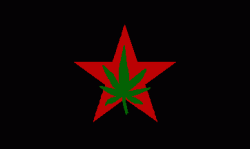
“Journalism is printing what someone else does not want printed. Everything else is public relations.”
—George Orwell
“More newspapermen have been ruined by self-importance than by liquor.”
—Walter Lippman
In 1970, living on the north side of Chicago, having recently graduated from Roosevelt University, I overcame an ambition for graduate studies in philosophy and ended up working as a security guard at Aaron Russo’s Kinectic Playground (where Maya Rudolph’s father, Dick, was my boss) until a suspicious fire burned it to the ground. That left me substitute teaching on the west side of Chicago and then clerking at Sights and Sounds, a hip record shop on Sheridan Road in East Rogers Park.
In my abode were books written by Herman Hesse, Franz Fanon, Regis Debray, Kurt Vonnegut, Frank Herbert, RD Laing, and Richard Brautigan, Ramparts magazine, The Village Voice, and Chicago Seed. My cultural development was as fractured and diverse as the above bibliographical sketch suggests—and reflects a searching and probing restlessness that was endemic to youth and the times.
Among other things, I was working with the self-titled Radio Free Chicago, which purchased late-night airtime from a Polish language radio station. The impetus for this move was the firing of FM radio pioneer Bob Rudnick from WGLD-FM, for asserting on the air that the Chicago Police Department had murdered Black Panther Fred Hampton. So Rudnick, Steven Mrvos, Bruce Picard, and I programmed an overnight free-form time slot. Needless to say, it was non-commercial and frequently included music that was not radio music. But that was then.
The people interested in propagating the “liberation” of the air waves had progressive ambitions and politics, which today, no doubt, seem utopian. Social and economic justice, sexual liberation and freedom, spiritual awareness and rebirth, anti-militarism, anti-war, and anti-imperialism were all elements of public conversations taking place, representing a rapidly growing and evolving counterculture.
In June, we were invited to a conclave at Vermont’s Goddard College. The so-called Alternative Media Conference was organized by Goddard alumnus and free-form radio pioneer Larry Yurdin, “a revolutionary event with the goal of creating media that awakens rather than anesthetizes.” About 1,700 people attended, representing a broad array of media, activists, shamen, publicists, musicians, artists, and camp followers. Music legend Peter Wolf called it an “Elite Woodstock”. As Yurdin recalls,
The conference brought together many of the top countercultural figures in the music, radio, broadcast news, and television industries, most of whom had never met prior to this event. The conference was crucial in establishing business, creative, and personal connections, which continue to grow to this day.
Many attendees later contacted Yurdin to say that the conference changed their lives.
Recently, I was invited to another colloquium at Goddard, billing itself as an Alternative Media Conference. Eliciting fond memories, I was tempted to revisit that moment but, well, I opted to dwell in my memories and spare myself a trip beyond my zip code. In any case, reportedly less than 200 people attended the 40th anniversary event, few of whom I could identify as “alternative media.” This nostalgic journey in the wayback machine (devotees of The Rocky and Bullwinkle Show will get this reference) did raise my interest in how history had rendered this singular event and what it may have spawned.
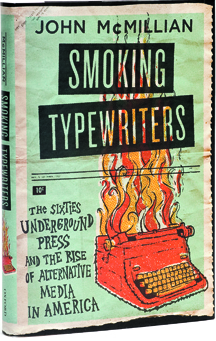
Smoking Typewriters: The Sixties Underground Press and the Rise of Alternative Media in America by John McMillian (Oxford University Press) is a fairly recent survey of late century American dissident and counter-cultural media. Sudan Brownmiller sums up:
John McMillian’s meticulous scholarship delves into the rambunctious, chaotic world of the counterculture weeklies that sprang up around the country, and mostly imploded, in the era of Vietnam, rock, psychedelics and pot. Smoking Typewriters (the witty title was a gift from Allen Ginsberg) explores the ambitions and private demons of several leading figures in the alternative press, notably Ray Mungo, Marshall Bloom, and Tom Forcade. The author parses-no easy task-the dizzily fractured political and sexual rebellions promoted by the founders, writers and cartoonists of the cheaply produced, offset, raggedy papers that thumbed a collective nose at The Establishment as they grooved on their beleaguered ‘underground’ status. I think he gets it right. This book is an enlightening contribution to a nation that still has not come to terms with The Sixties.
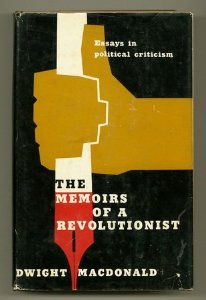
The Memoirs of a Revolutionist by Dwight Macdonald (Farrar, Straus and Cudahy): journalist and public intellectual MacDonald’s body of work still inspires to speak truth to power.
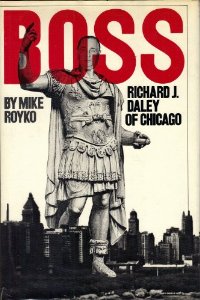
Boss by Mike Royko (Dutton): The Chicago Daily News’s Mike Royko, the original everyman’s ink bespotted scribbler, crafted a non-scholastic biography of all-powerful Mayor Richard J. Daly (Richard the First). Royko was emulated by many, especially a Boston columnist who was eventually defrocked for violating certain journalistic standards.
The Best of I.F. Stone by I.F. Stone (PublicAffairs): I.F. Stone’s Weekly was the 1960’s quintessential gadfly publication produced by irascible newspaperman I.F. Stone. Publisher Peter Osnos introduces this anthology:
What makes this collection of The Best of I.F. Stone valuable is that it seems so relevant to our times. Some aspects of language have changed: calling oneself a “newspaperman” seems quaint in today’s media-driven, gender-neutral world, but otherwise, Stone’s wisdom, informing his perceptions and framing his arguments, reads with spectacular currency. One small measure of Izzy’s lasting influence can be found in a quintessential twenty-first exercise. If you type in “I.F. Stone” on Google, you come up with 237,000 items. That is an impressive amount for what Izzy described in 1963 as a “four-page miniature journal of news and opinion,” a publication long gone, but clearly not forgotten.
For a full biography of Stone, see All Governments Lie: The Life and Times of Rebel Journalist I.F. Stone by Myra MacPherson.
Uncovering the Sixties: The Life and Times of the Underground Press by Abe Peck (Citadel Press): Peck was the editor of the Rat and The Chicago Seed and later a mentor at Northwestern University’s Medill School of Journalism. Peck argues that the underground’s origins stemmed from Mad magazine. He chronicles major market tabloids such as The Los Angeles Free Press, The East Village Other, the San Francisco Oracle, the Berkeley Barb, and Austin Rag—and diligently interviewed writers, readers, and publishers of the underground press. By 1969, at its peak, the alternative press numbered more than 500 papers with millions of readers. By 1973, with the winding down of the Vietnam War and the evaporation of the peace movement, the papers were disappearing—replaced, of course, by an epidemic of lifestyle weeklies and market-driven catalogues.
Voices of Revolution: The Dissident Press in America by Rodger Streitmatter (Columbia University Press): this book surveys the abolitionist and labor press, black power publications of the 1960s, the women’s movement, and anti-war journals. Streitmatter also discusses gay and lesbian publications and contemporary online journals. Streitmatter’s scope is the early 19th century to the present.
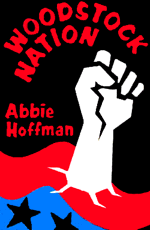
Revolution for the Hell of It: The Book That Earned Abbie Hoffman a Five-Year Prison Term at the Chicago Conspiracy Trial and Woodstock Nation: A Talk-Rock Album by Abbie Hoffman (Vintage Books): Hoffman was a founder—along with Anita Hoffman, Jerry Rubin, Nancy Kurshan, and Paul Krassner—of the Youth International Party (Yippie) and a member of the Chicago Seven/Eight. An anti-war activist, Hoffman was a deft street theater proponent and, unlike others, an unrepentant and unrehabilitated radical who stayed true to his beliefs until the end of his life.
And if you don’t know the story of the Chicago Seven/Eight: Amid the roiling political seas of the 1960s, the 1968 Democratic Convention in Chicago was a perfect storm of police riots, backroom politics, anti-war demonstrations, and TV drama, as anti-war candidate Senator Eugene McCarthy tilted his lance at the Democratic Party windmill. Out of those tempestuous days, the federal government indicted eight activists: Abbie Hoffman, Jerry Rubin, David Dellinger, Tom Hayden, Rennie Davis, John Froines, Bobby Seale and Lee Weiner. They were charged with conspiracy and inciting riot, among other charges. The trial that ensued was an entertaining display of government chicanery and political street theater. The City of Chicago had refused permits to parade in Lincoln Park, which sparked police violence. Hoffman testified:
I pointed out that it was in the best interests of the City to have us in Lincoln Park ten miles away from the Convention hall. I said we had no intention of marching on the convention hall, that I didn’t particularly think that politics in America could be changed by marches and rallies, that what we were presenting was an alternative lifestyle, and we hoped that people of Chicago would come up, and mingle in Lincoln Park and see what we were about.
In February 1970, seven defendants were found not guilty of conspiracy. Five were convicted of crossing state lines with the intent to incite a riot. On February 20, they were sentenced to five years in prison.
Two films were made of the Chicago Seven (or Eight) Trial. HBO’s 1987 Conspiracy: The Trial of the Chicago 8 is a docudrama that re-enacted the trial using the court transcript as the primary source for the script.
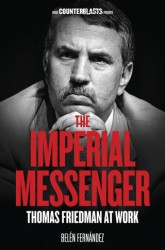
The Imperial Messenger: Thomas Friedman at Work (Verso) by Belén Fernández is brilliant and insightful and (if you suspect that thrice Pulitzer Prize–winning Friedman is frequently incomprehensible) amusing. It’s a fine example of mucking through conventional wisdom and collaborationist cant. The late Alexander Cockburn (no shrinking violet, he) enthused, “Filleting the silliest man on the planet needs a sure scalpel, and Belén Fernández wields hers with deadly finesse.”
Films
• You can find the story of the transformation of the so-called underground press to alternative writ large in Joan Micklin Silver’s film Between the Lines.
• The best film I know of that represents the roiling times of the Vietnam war era is Haskell Wexler’s Medium Cool.
Periodicals and Online Publications
Happily (and luckily for you) I have no interest in firming up the taxonomy of the categories underground, dissident, and alternative—or assessing the influence of journalists incubated on the margins. I do encourage readers to have a gander at these venues:
• The Baffler
• Counter Punch
• Democracy Now
• Jacobin
• Mother Jones
• In These Times
• Truth Digs
• Tom’sDispatch
• The Realist
Looking back on those evanescent moments of my alternative media days, I am struck by the irrational or, better yet, the non-rational sense I get when I hear Alan Ginsburg and read his zeitgeist magnum opus, Howl. A nearly 30-minute crescendo. Naturally there is a feature film about Ginsburg, Howl.
I saw the best minds of my generation destroyed by madness, starving hysterical naked,
dragging themselves through the negro streets at dawn looking for an angry fix,
angelheaded hipsters burning for the ancient heavenly connection to the starry dynamo in the machinery of night
